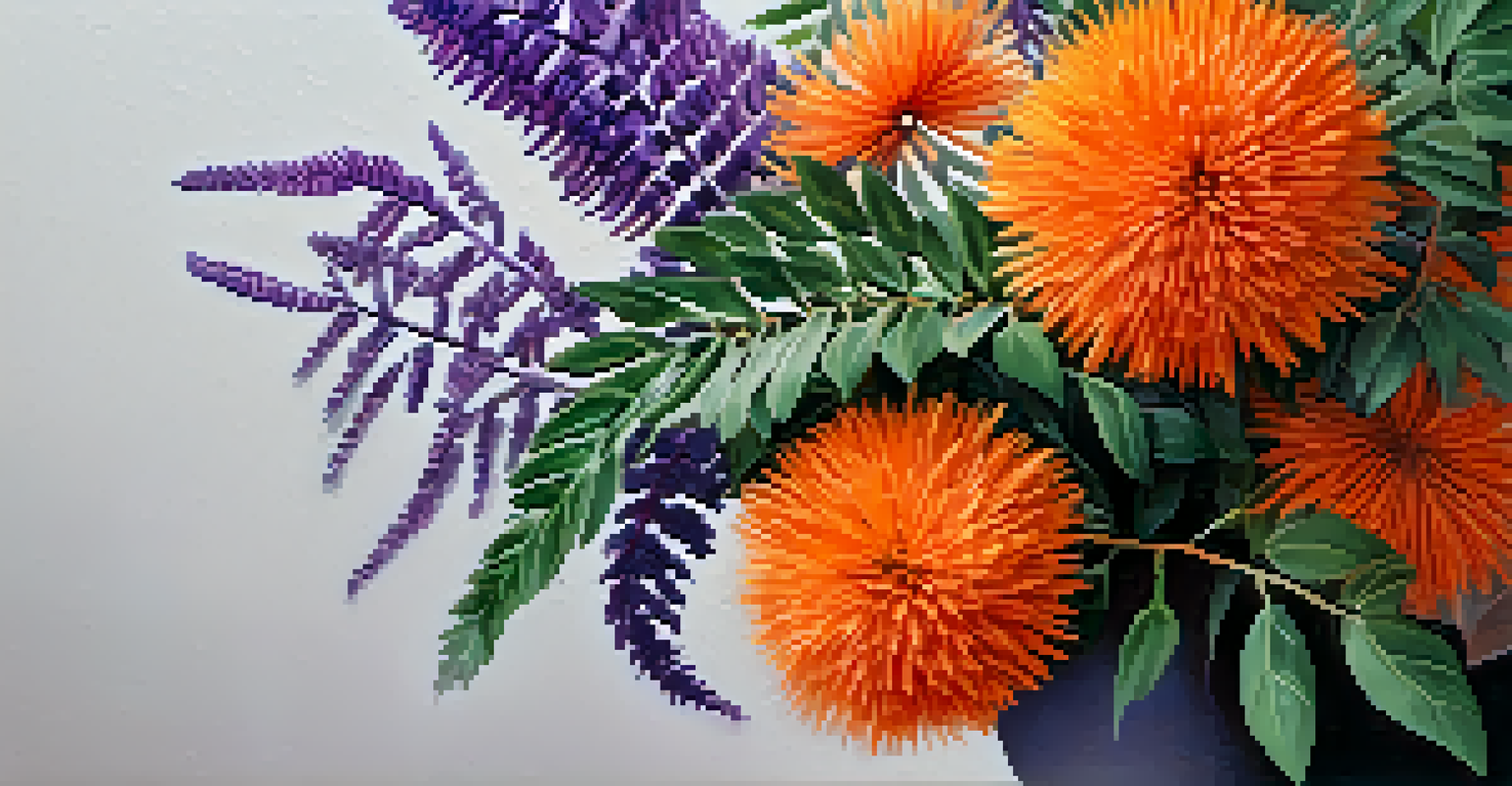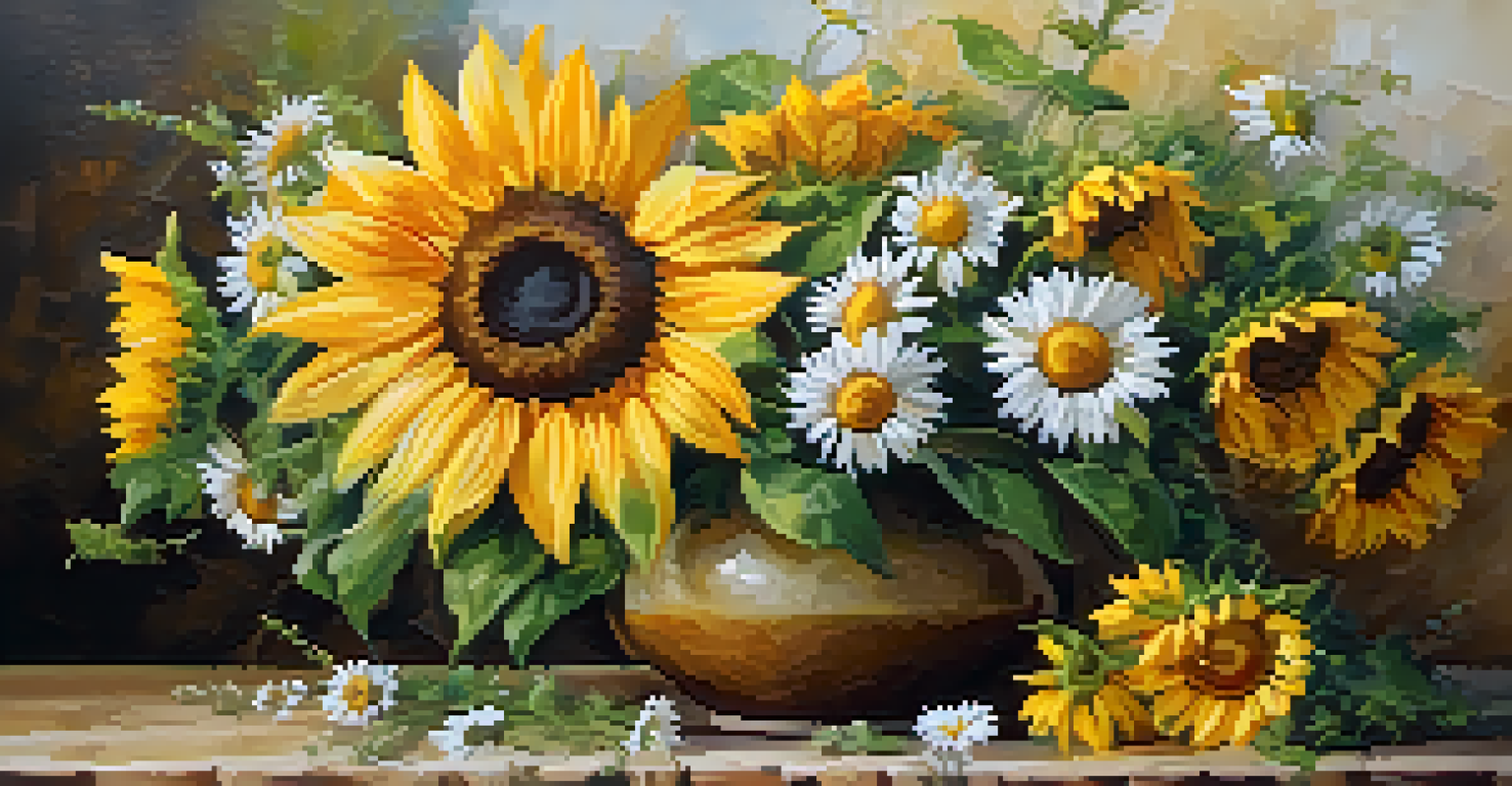Creating Textured Floral Arrangements: Tips and Tricks

Understanding the Importance of Texture in Floral Design
Texture plays a vital role in floral arrangements, adding depth and interest. Think of it like the fabric of a beautiful outfit—different textures can transform the entire look. By incorporating various flower types and materials, you can create a dynamic visual experience that captures attention.
Flowers are like friends; they bring color to your world.
When you mix smooth petals with rougher elements like branches or foliage, you create a more engaging arrangement. This contrast not only appeals to the eye but also evokes emotions, making your floral design more memorable. A well-textured arrangement can tell a story and draw people in.
Ultimately, understanding how texture enhances your floral designs can elevate your work from ordinary to extraordinary. It’s all about creating a balanced composition that invites viewers to look closer and appreciate the subtleties of your arrangement.
Choosing the Right Flowers for Texture
When it comes to selecting flowers, consider their shapes, sizes, and petal textures. For example, the velvety softness of a rose contrasts beautifully with the spiky petals of thistles. By combining different flowers, you can achieve a rich tapestry of textures that brings your arrangement to life.

Don’t forget to incorporate fillers like baby’s breath or seasonal foliage, which can add another layer of texture. These smaller elements often act as a bridge between the larger flowers, guiding the viewer's eye throughout the arrangement. Mixing large blooms with delicate fillers creates a balanced and inviting composition.
Texture Enhances Floral Arrangements
Incorporating varied textures in floral designs adds depth and emotional appeal, transforming ordinary arrangements into extraordinary experiences.
Remember, the goal is to create a harmonious blend of textures that work together rather than compete. Take some time to experiment with various flower combinations to discover what feels right for your design.
Incorporating Foliage for Depth and Contrast
Foliage is a crucial element in textured floral arrangements, providing depth and contrast. Think of leaves as the backdrop to your vibrant flowers; they help to frame and highlight the main attraction. By using different types of greenery, you can enhance the overall texture of your design.
The beauty of a flower is not just in its color but in its texture and form.
Consider using both structured leaves, like eucalyptus, and softer varieties, such as ferns, to create visual interest. Each type of foliage brings its own unique texture, helping to balance the arrangement. This contrast can make the flowers pop even more, drawing attention to their beauty.
Incorporating foliage not only adds texture but also helps to fill out your arrangement. A well-placed leaf can create a focal point or lead the eye through the design, making it feel complete and thoughtfully arranged.
Layering Techniques for Textured Arrangements
Layering is an essential technique in creating textured floral arrangements. By stacking different elements—like flowers, foliage, and fillers—you add dimension and complexity. Imagine building a cake: each layer contributes to the overall flavor and appearance, making it more appealing.
Start by placing larger flowers in the center, then build outwards with medium and smaller blooms. This graduated layering creates a natural flow, allowing your arrangement to feel cohesive. Don’t shy away from overlapping elements; this adds to the texture and intrigue.
Foliage Adds Depth and Contrast
Using different types of foliage not only provides a backdrop for flowers but also enhances the overall texture and balance of the arrangement.
Finally, consider the height and angle of your layers. Varying the heights of your flowers can create a sense of movement, making the arrangement feel alive. Experiment with different layouts to find what works best for your vision.
Color Contrast: Enhancing Texture with Color
Color is another powerful tool in creating textured floral arrangements. Different colors can evoke different emotions and highlight various textures within your design. For instance, warm colors like reds and oranges can create a vibrant feel, while cooler tones like blues and greens can bring a sense of calm.
When combining colors, consider their contrasts and complements. A burst of bright flowers against deep green foliage can enhance the textures you’ve created, making each element stand out. This interplay between color and texture can create a more dynamic and eye-catching arrangement.
Don’t be afraid to experiment with unexpected color pairings. Sometimes, the most striking arrangements come from bold color choices that challenge traditional norms. Let your creativity guide you and see where it takes your floral designs.
Utilizing Unique Materials for Added Texture
To elevate your textured floral arrangements, consider incorporating unique materials beyond traditional flowers and foliage. Items like pinecones, feathers, or even dried fruits can add unexpected elements and a unique flair. These materials can serve as conversation starters and add a personal touch to your work.
Think of these unique materials as the spices in your floral recipe. Just a dash can enhance the overall flavor of your arrangement, making it more memorable. They also provide additional textures that can beautifully complement your flowers.
Layering Creates Dimension
Layering flowers, foliage, and fillers allows for a cohesive flow and adds complexity, much like building a multi-layered cake.
When using these materials, be mindful of their placement. Balance is key; you want these elements to enhance, not overwhelm, your floral design. With thoughtful integration, you can create arrangements that are both visually stunning and rich in texture.
Final Touches: Completing Your Textured Floral Arrangement
Once you've assembled your arrangement, it's time for those final touches that can make a significant difference. Step back and assess the overall composition; look for areas that may need more texture or balance. Sometimes, a few well-placed flowers or leaves can tie the whole piece together.
Consider adding accessories like decorative ribbons or stylish vases that complement your design. These finishing elements can enhance the texture and elevate the overall look of your arrangement. Think of them as the cherry on top of your floral masterpiece.

Finally, don’t forget to care for your arrangement. Proper watering and maintenance will keep your flowers looking fresh and vibrant, allowing the textures to shine. A little attention goes a long way in ensuring your creation is enjoyed for days to come.